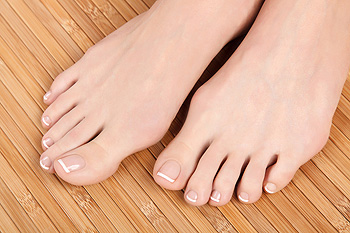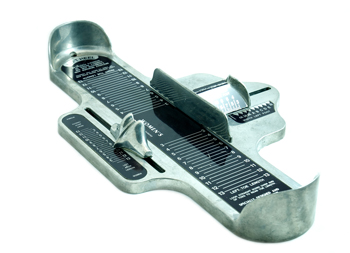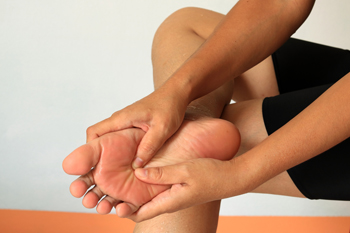Houston
Pearland
 The ball of the foot is located between the arch of the foot and the toes, and it primarily contains metatarsal bones. While walking, weight is transferred from the heel to the ball of the foot, and an uneven weight transfer can cause pain and swelling in that area. As you get older, the fat pad at the bottom of the foot can wear away and cause shock to the ball of the foot. Pain in the ball of the foot can also be caused by high arches, obesity, arthritis, ill-fitting shoes, and wearing high heels too often. If you are looking to manage and limit this type of pain from becoming worse, please consult with a podiatrist for professional guidance.
The ball of the foot is located between the arch of the foot and the toes, and it primarily contains metatarsal bones. While walking, weight is transferred from the heel to the ball of the foot, and an uneven weight transfer can cause pain and swelling in that area. As you get older, the fat pad at the bottom of the foot can wear away and cause shock to the ball of the foot. Pain in the ball of the foot can also be caused by high arches, obesity, arthritis, ill-fitting shoes, and wearing high heels too often. If you are looking to manage and limit this type of pain from becoming worse, please consult with a podiatrist for professional guidance.
Foot Pain
Foot pain can be extremely painful and debilitating. If you have a foot pain, consult with Dr. Linda D. Nachmani from Central Foot & Ankle Associates. Our doctor will assess your condition and provide you with quality foot and ankle treatment.
Causes
Foot pain is a very broad condition that could be caused by one or more ailments. The most common include:
Diagnosis
To figure out the cause of foot pain, podiatrists utilize several different methods. This can range from simple visual inspections and sensation tests to X-rays and MRI scans. Prior medical history, family medical history, and any recent physical traumatic events will all be taken into consideration for a proper diagnosis.
Treatment
Treatment depends upon the cause of the foot pain. Whether it is resting, staying off the foot, or having surgery; podiatrists have a number of treatment options available for foot pain.
If you have any questions, please feel free to contact one of our offices located in Houston, and Pearland, TX. We offer the newest diagnostic and treatment technologies for all your foot care needs.
Read more about Foot Pain When purchasing shoes, it’s important to make sure you choose the correct size shoe by figuring out the accurate length and width of your foot. This can be found by measuring your foot at the end of the day when the feet are at their largest. It would also be beneficial to wear the same or similar socks while trying shoes on, as this may help to ensure a proper fit. Many shoe stores have a measuring tool that is known as a Brannock device, which can help to determine the correct size of your foot. Some patients prefer to stand on a piece of paper while tracing their feet. Both feet are rarely the same size, and it is suggested to use the size of the larger foot. It is beneficial to choose a style shoe that fits comfortably when tried on and to avoid shoes that have to be broken in. If you would like additional information about how to determine your correct shoe size, please consult with a podiatrist.
When purchasing shoes, it’s important to make sure you choose the correct size shoe by figuring out the accurate length and width of your foot. This can be found by measuring your foot at the end of the day when the feet are at their largest. It would also be beneficial to wear the same or similar socks while trying shoes on, as this may help to ensure a proper fit. Many shoe stores have a measuring tool that is known as a Brannock device, which can help to determine the correct size of your foot. Some patients prefer to stand on a piece of paper while tracing their feet. Both feet are rarely the same size, and it is suggested to use the size of the larger foot. It is beneficial to choose a style shoe that fits comfortably when tried on and to avoid shoes that have to be broken in. If you would like additional information about how to determine your correct shoe size, please consult with a podiatrist.
Getting the right shoe size is an important part of proper foot health. Seek the assistance of Dr. Linda D. Nachmani from Central Foot & Ankle Associates. Our doctor will provide the care you need to keep you pain-free and on your feet.
Getting the Right Shoe Size
There are many people who wear shoes that are the incorrect size, negatively affecting their feet and posture. Selecting the right shoes is not a difficult process, so long as you keep several things in mind when it comes to choosing the right pair.
As our feet hold our body weight and keep us moving, it is important to treat them right. Picking the right pair of shoes can provide your feet comfort and mobility without pain.
If you have any questions, please feel free to contact one of our offices located in Houston, and Pearland, TX. We offer the newest diagnostic and treatment technologies for all your foot care needs.
Read more about Getting the Right Shoe Size: To Keep Your Feet HappyA nerve tissue that has become thickened is referred to as a neuroma. If the tissue that is found between the toes near the ball of the foot becomes inflamed, it is a condition that is known as Morton’s neuroma. It can happen as a result of wearing shoes that are too narrow, or from participating in sporting activities where pressure is placed on the front of the foot. Additionally, it may develop from existing foot deformities that can include flat feet and bunions. A noticeable symptom that patients could have is a burning pain on the sole of the foot, which may travel to the toes. Mild relief may be found when orthotics are worn, and this may give the affected foot the support that is needed as the pressure is reduced. It can be beneficial to avoid wearing high heels, and choosing to wear shoes that are wider in the toe area may be more comfortable. If you have a sharp pain on the bottom of your foot, it is suggested that you speak with a podiatrist who can properly diagnose and treat Morton’s neuroma.
Morton’s neuroma is a very uncomfortable condition to live with. If you think you have Morton’s neuroma, contact Dr. Linda D. Nachmani of Central Foot & Ankle Associates. Our doctor will attend to all of your foot care needs and answer any of your related questions.
Morton’s Neuroma
Morton's neuroma is a painful foot condition that commonly affects the areas between the second and third or third and fourth toe, although other areas of the foot are also susceptible. Morton’s neuroma is caused by an inflamed nerve in the foot that is being squeezed and aggravated by surrounding bones.
What Increases the Chances of Having Morton’s Neuroma?
Morton’s neuroma is a very treatable condition. Orthotics and shoe inserts can often be used to alleviate the pain on the forefront of the feet. In more severe cases, corticosteroids can also be prescribed. In order to figure out the best treatment for your neuroma, it’s recommended to seek the care of a podiatrist who can diagnose your condition and provide different treatment options.
If you have any questions, please feel free to contact one of our offices located in Houston, and Pearland, TX. We offer the newest diagnostic and treatment technologies for all your foot care needs.
Read more about What is Morton's Neuroma? The symptoms that are associated with the condition known as tarsal tunnel syndrome can consist of numbness and tingling on the bottom of the foot. This can be a result of pressure that is exerted on the tibial nerve which is located in the ankle area. Relief may be found when orthotics are worn, and this may help to reduce strain on this nerve. In severe cases, surgery may be a necessary option that can successfully release tension. As the foot heals, certain stretches can be performed that can help to increase range of motion in your ankle. If you are experiencing pain, numbness, or a tingling feeling on the sole of your foot, it is strongly recommended that you are under the care of a podiatrist who can properly diagnose and treat tarsal tunnel syndrome.
The symptoms that are associated with the condition known as tarsal tunnel syndrome can consist of numbness and tingling on the bottom of the foot. This can be a result of pressure that is exerted on the tibial nerve which is located in the ankle area. Relief may be found when orthotics are worn, and this may help to reduce strain on this nerve. In severe cases, surgery may be a necessary option that can successfully release tension. As the foot heals, certain stretches can be performed that can help to increase range of motion in your ankle. If you are experiencing pain, numbness, or a tingling feeling on the sole of your foot, it is strongly recommended that you are under the care of a podiatrist who can properly diagnose and treat tarsal tunnel syndrome.
Tarsal tunnel syndrome can be very uncomfortable to live with. If you are experiencing tarsal tunnel syndrome, contact Dr. Linda D. Nachmani of Central Foot & Ankle Associates. Our doctor can provide the care you need to keep you pain-free and on your feet.
Tarsal Tunnel Syndrome
Tarsal tunnel syndrome, which can also be called tibial nerve dysfunction, is an uncommon condition of misfiring peripheral nerves in the foot. The tibial nerve is the peripheral nerve in the leg responsible for sensation and movement of the foot and calf muscles. In tarsal tunnel syndrome, the tibial nerve is damaged, causing problems with movement and feeling in the foot of the affected leg.
Common Cause of Tarsal Tunnel Syndrome
The Effects of Tarsal Tunnel Syndrome
A physical exam of the leg can help identify the presence of tarsal tunnel syndrome. Medical tests, such as a nerve biopsy, are also used to diagnose the condition. Patients may receive physical therapy and prescriptive medication. In extreme cases, some may require surgery.
If you have any questions please feel free to contact one of our offices located in Houston, and Pearland, TX. We offer the newest diagnostic and treatment technologies for all your foot and ankle needs.
Read more about Tarsal Tunnel Syndrome Those suffering from plantar fasciitis are often familiar to the heel pain that is associated with this condition. To help ease the discomfort of plantar fasciitis, there are a few methods you can practice. To begin, you should regularly rest and elevate the affected area. Icing your feet can also help with relieving pain as well as inflammation. Some patients have found the use of custom orthotics to be helpful. Ill-fitting footwear is often a common cause for plantar fasciitis, so using custom orthotics can be helpful in preventing this ailment from becoming worse. Lastly, regularly performing foot and calf stretches can be beneficial in reducing the pain of plantar fasciitis. For more information on how to treat this condition, please consult with a podiatrist for professional care.
Those suffering from plantar fasciitis are often familiar to the heel pain that is associated with this condition. To help ease the discomfort of plantar fasciitis, there are a few methods you can practice. To begin, you should regularly rest and elevate the affected area. Icing your feet can also help with relieving pain as well as inflammation. Some patients have found the use of custom orthotics to be helpful. Ill-fitting footwear is often a common cause for plantar fasciitis, so using custom orthotics can be helpful in preventing this ailment from becoming worse. Lastly, regularly performing foot and calf stretches can be beneficial in reducing the pain of plantar fasciitis. For more information on how to treat this condition, please consult with a podiatrist for professional care.
Plantar fasciitis is a common foot condition that is often caused by a strain injury. If you are experiencing heel pain or symptoms of plantar fasciitis, contact Dr. Linda D. Nachmani from Central Foot & Ankle Associates. Our doctor can provide the care you need to keep you pain-free and on your feet.
What Is Plantar Fasciitis?
Plantar fasciitis is one of the most common causes of heel pain. The plantar fascia is a ligament that connects your heel to the front of your foot. When this ligament becomes inflamed, plantar fasciitis is the result. If you have plantar fasciitis you will have a stabbing pain that usually occurs with your first steps in the morning. As the day progresses and you walk around more, this pain will start to disappear, but it will return after long periods of standing or sitting.
What Causes Plantar Fasciitis?
There are some risk factors that may make you more likely to develop plantar fasciitis compared to others. The condition most commonly affects adults between the ages of 40 and 60. It also tends to affect people who are obese because the extra pounds result in extra stress being placed on the plantar fascia.
Prevention
There are a variety of treatment options available for plantar fasciitis along with the pain that accompanies it. Additionally, physical therapy is a very important component in the treatment process. It is important that you meet with your podiatrist to determine which treatment option is best for you.
If you have any questions, please feel free to contact one of our offices located in Houston, and Pearland, TX. We offer the newest diagnostic and treatment technologies for all your foot care needs.
Read more about Plantar Fasciitis